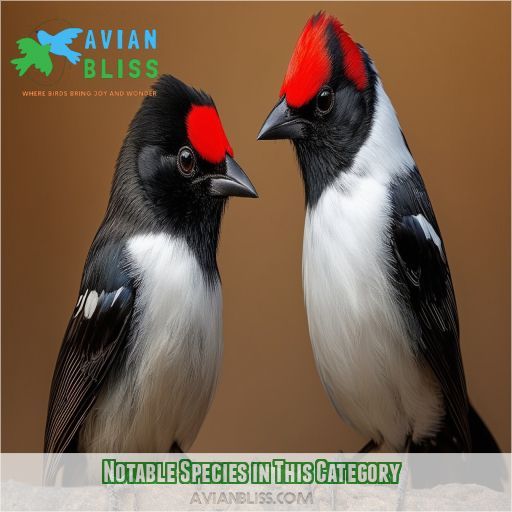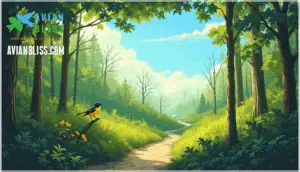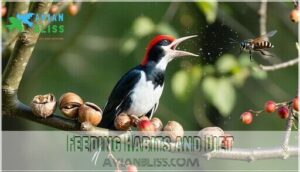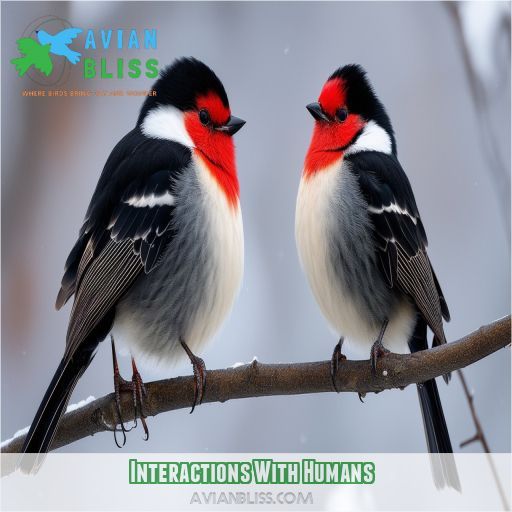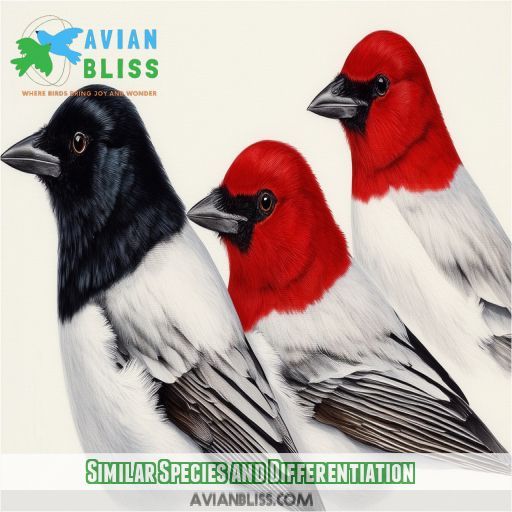This site is supported by our readers. We may earn a commission, at no cost to you, if you purchase through links.

The article describes all aspects of identification, habitat, and behaviors for these noted species: the red-headed woodpecker and Acorn Woodpecker, indicating their description and characteristic markings.
Learn about preferred ecosystems and feeding habits, breeding, and nesting behaviors.
Learn their vocalizations, conservation status, and other unique adaptations that make them special—very nice insights for a birdwatcher or nature enthusiast
Table Of Contents
- Key Takeaways
- Identifying Red-Headed Black and White Birds
- Notable Species in This Category
- Habitat and Distribution
- Feeding Habits and Diet
- Breeding and Nesting Behaviors
- Vocalizations and Communication
- Conservation Status and Threats
- Adaptations and Unique Features
- Interactions With Humans
- Similar Species and Differentiation
- Frequently Asked Questions (FAQs)
- Conclusion
Key Takeaways
- Keep your eyes peeled for vibrant contrasts of red heads against black and white bodies, a signature look of these birds.
- Remember, these birds are not just pretty faces; their specialized bills and climbing skills make them masters of their arboreal habitats.
- Lend a helping hand by providing backyard feeders and creating a welcoming environment with native trees – think of it as a five-star hotel for your feathered friends!
- Respect their wild nature and leave them to their natural ways – they’re not meant to be caged, but rather soaring free in the skies
Identifying Red-Headed Black and White Birds
When identifying red-headed black and white birds, you’ll want to focus on their physical characteristics, distinctive markings, and overall size and shape. Look for the striking contrast between the bright red head, black body parts, and white areas, paying attention to unique patterns on wings, back, and belly that can help distinguish between species
Physical Characteristics
You’ll spot these striking birds by their vibrant red heads contrasting sharply with black and white bodies. Their large, chisel-like bills are perfect for drilling into wood. Wing patterns vary, with adults showing distinctive white patches.
These birds are masters of food storage, tucking away morsels in tree crevices. They’re fierce defenders of their territory and construct nests with precision.
Sadly, many species, like the red-headed woodpecker, face population decline due to habitat loss
Distinctive Markings
You’ll spot these striking birds by their vibrant red heads contrasting sharply with black-and-white bodies.
Look for distinctive feather patterns, like the red-bellied woodpecker‘s black-and-white striped back or the red-headed woodpecker’s solid black back with large white patches. In flight, you’ll notice their unique wing patterns.
Their beak shape, often long and chisel-like, hints at their varied diet and habitat preferences, from forest edges to open woodlands
Size and Shape
Beyond their striking markings, you’ll find these red-headed black and white birds have distinct sizes and shapes.
The red-headed woodpecker, for instance, boasts a body length of 7.5-9.1 inches and a wingspan of 16.5 inches. They’re medium-sized, about as big as a robin.
Their compact, stocky build is perfect for their woodland habitat. When you spot one, you’ll notice its proportions are well-balanced, with a large head and strong, chisel-like bill
Notable Species in This Category
You’ll encounter several notable species of black and white birds with red heads, including the Red-Headed Woodpecker, Acorn Woodpecker, and Red-Breasted Sapsucker. These distinctive birds share similar color patterns but have unique characteristics that set them apart, making them fascinating subjects for birdwatchers and nature enthusiasts alike
Red-Headed Woodpecker
You will be beguiled by the brilliant beauty of a red-headed woodpecker. This scene genuinely is a part of Mother Nature’s masterpieces—its head color is a very striking red, contrasting to a snow-white body with half-black wings that delight a birdwatcher. Yet, for this beautiful species, there are challenges:
- Declining populations due to habitat loss
- Food availability is in struggle with changing ecosystems
• Effects of climate change on their preferred habitats
Conservation work and habitat restoration is a fundamental way to work towards ensuring these flying checker-boards continue to grace our woodlands and inspiring the enjoyment of future generations of people inspired by birds.
Acorn Woodpecker
The Acorn Woodpecker, known for its vivid red head, specializes in acorn storage. Found in oak woodlands, their black and white markings make them distinctive. Juveniles have less vibrant plumage.
This bird’s population is declining due to habitat loss. Conservation efforts focus on preserving oak habitats.
Unlike the Golden-fronted or Ladder-backed Woodpeckers, Acorn Woodpeckers store acorns in trees for future use
Red-Breasted Sapsucker
The Red-breasted Sapsucker’s bright red cap and black-and-white zebra-striped body make it one of the more striking birds. Indeed, its sapsucker beak makes it adept at drilling neat rows in bark crevices to get at the sap.
These birds perform some portico-pica-like behavior and are famous for sapsucker drumming that marks their territory. They migrate seasonally on their circuits between summer grounds and wintering grounds but come together to nest in tree cavities. Due to habitat threats, conservation efforts are significant.
You can always spot them flying rapidly through forests and open woodlands
Habitat and Distribution
Black and white birds with red heads thrive in diverse habitats, including pine savannas, open woodlands, and scattered agricultural areas. Their geographic range spans North America, with some species exhibiting specific migration patterns based on seasonal changes
Preferred Ecosystems
You’ll often spot these striking birds in pine savannas, open woodlands, and dead timber in swamps. They also thrive in agricultural areas and scattered woodlots. Imagine a cardinal darting between trees or a warbler flitting around. These vibrant habitats provide ample food and shelter, allowing them to perch, forage, and store food securely, with white patches and all
Geographic Range
You’ll find these black and white birds with red heads across North America, from Canada to the southern United States. The geographic distribution spans various regions.
Habitat fragmentation and range expansion can impact species like the Red-cockaded Woodpecker. Forest loss contributes to population declines, leading to conservation measures.
These birds adapt to scattered woodlots, agricultural areas, and extensive forests, ensuring their survival
Migration Patterns
During migration, red-headed black and white birds undertake long-distance flights guided by environmental cues. They follow established migration routes to reach their wintering grounds. You might see them abruptly changing direction, taking over new territories, and taking off again in quick chatter. Seasonal movements between breeding and feeding grounds showcase their agility, with distinct large white patches visible during flight
Feeding Habits and Diet
The red-headed woodpeckers are skilled foragers, adeptly catching insects in the air and storing grasshoppers alive in tree crevices. Their diet varies seasonally, with a focus on insects during the summer and nuts, berries, and stored food during the winter months
Foraging Techniques
Foraging, these birds are a marvel. They catch insects in their flight gracefully and store food between the crevices of trees and even in fence posts for lean times. Here’s how they make it work all the more efficiently:
- Evasive Action: swift maneuvers that enables escape of prey.
- Site Selection: Deciding where to cache food items in safe places.
- Inter-Specific Competition: They fight long and bitterly for their valuable turf.
- Insecticide Exposure: Avoiding areas with harmful chemicals ensures survival.
Food Preferences
These birds are pretty versatile as far as food preferences are concerned. They have an omnivorous diet consisting of insects, seeds, and fruits.
You’ll see them pursuing insects mid-air or hammering into hollows of trees for succulent larvae.
Seed caching, particularly of acorns, often occurs.
Their black-and-white wings and brown-and-black barred backs truly set them apart while foraging, really adding to their charm
Seasonal Variations
Seasonal changes impact these birds’ feeding habits and diet. In winter, food availability often dictates their behavior and prompts migration. During the breeding season, their diet shifts to include more protein-rich insects:
- Food Availability: Wedges large nuts and stores them in tree crevices.
- Seasonal Migration: Adapts to changing climates.
- Mating Season: Intensifies food collection for nest building and rearing young
Breeding and Nesting Behaviors
Speaking of breeding and nesting, all the red-headed black and white birds have relatively rare kinds of courtship rituals, and they’re careful in building their nests. These involve high levels of parental care by both partners, who attend to affairs including but not limited to feeding and protection of the young.
Courtship Rituals
In their mating rituals, black and white birds with red heads engage in lively displays to attract mates, including vocal and physical demonstrations. They select nesting sites with great care, often preferring tree cavities.
Pair bonding includes mutual feeding and synchronized activities, solidifying their connection. Territorial defense becomes intense, with both partners aggressively warding off intruders.
Egg incubation is shared, ensuring the next generation’s success
Nest Construction
Nests are something they design carefully. The birds begin to chisel cavities in dead or even dying wood to form very secure houses.
- Nesting material: Largely of wood chips and bark.
- Nest location: Dead trees, fence posts.
- Nest design: deep cavities lined with soft materials.
- Nest defense: Vigorously guard their sites.
- Nest reuse: Tend to reuse old nests
Parental Care
You are looking at pretty remarkable parental care here. Parents vigorously defend nests and thus offspring. In terms of feeding, both parents bring a wide variety of food to foster strong development of the juveniles. By defending and raising, parental bonding is strengthened. Here is a brief overview:
| Aspect | Male Role | Female Role | Shared Duty |
|---|---|---|---|
| Defense of the nest | Aggressive defense | Alarm calls | Joint vigilance |
| Feeding | Gathers insects | Feeds chicks | Food delivery |
| Juvenile Care | Foraging Teaching | Warming provision | Guided flying |
| Nest Cleanliness | Disposes of wastes | Cleans the nest | Keeps clean |
Vocalizations and Communication
Understanding vocalizations and communication is essential for recognizing black and white birds with red heads. You’ll hear distinctive calls and songs, which serve as territorial displays and mating signals, helping to identify and differentiate these remarkable birds
Calls and Songs
The Black and White Birds with Red Heads are songbirds. Calls and songs differ among species, but their functions are generally very similar.
Their songs are usually complex and part of a mating signal or courtship used during the prenuptial period when individuals seek mates.
Some deliver characteristic calls to alert others to predators or food essential for survival or success in reproduction
Territorial Displays
You’ll witness fierce territorial defense from these red-headed birds. They show their aggression toward rivals through loud calls, striking displays, and hammering on wood to demarcate the boundaries.
Their defense strategies include frequent patrolling of their area and physical confrontations.
Protection of the nest is paramount since they relentlessly remove any intruding eggs to provide a safe zone for their offspring
Mating Signals
These birds are performing artists when it comes to mating displays. Vocalizations, however, can be used as courtship behaviors, and the males typically use distinctive calls to win the females over. Their territorial defense goes a notch higher, with more displays of dull tails, and this time, they fly in circles.
Female preferences lie and would thus choose males to express toughness and vitality, which are necessary for sexual selection
Conservation Status and Threats
You should be aware that the populations of black and white birds with red heads, like the Red-headed Woodpecker, are declining mainly due to significant habitat loss and changes in their food supply (Source). Climate change also impacts their breeding patterns and migration routes, exacerbating the situation
Population Trends
Population decline in black and white birds with red heads is a growing concern. Conservation efforts focus on counteracting habitat destruction and food scarcity. Climate change exacerbates these issues, further stressing bird populations.
Collaborative endeavors between scientists and conservationists aim to mitigate these threats, ensuring these striking birds don’t vanish from the skies. Immediate action is essential to reverse the worrying trends
Habitat Loss
Habitat loss greatly threatens black-and-white birds with red heads. You’ll find their numbers dwindling due to:
- Habitat fragmentation: Breaking up large forests into smaller patches.
- Food scarcity: Less food as trees are removed or insects diminish.
- Human encroachment and urbanization: Expanding cities and agricultural lands reduce their natural spaces.
These birds need connected, untouched woodlands to thrive
Climate Change Impact
Climate change intensifies habitat shifts, which challenge black and white birds with red heads. With rising temperatures, their ecosystems alter, leading to behavioral changes and impacting food sources. Shifting climates and prey availability directly contribute to population declines, disrupting traditional nesting and foraging patterns. These environmental changes force birds to adapt rapidly, straining their survival and affecting overall species resilience
Adaptations and Unique Features
These birds are equipped with specialized bills that allow them to efficiently extract insects and other food from tree bark. Their climbing abilities, combined with the contrasting plumage, help them navigate and defend their arboreal territories effectively
Bill Specializations
These specializations in the bill are critical for the bird’s survival. The unique bill morphology allows effective foraging strategies. You can see how they chisel into wood, capture insects in the air, and store food in crevices.
This provides versatility that aids in predator evasion and supports complex social hierarchies. Their food-storage methods, such as keeping grasshoppers alive, ensure there’s always a supply of food even when it might be needed most: scarcity
Climbing Abilities
Birds with redheads and a black and white body regularly climb and are excellent climbers. They use a mixture of climbing techniques
- Clinging onto a tree with powerful thorny nails
- Using their stiff tail feathers for support
- They use their powerful, chisel-like bills to forage most effectively
- Navigating shared habitats while exhibiting territorial aggression
These features make them masters at the exploitation of tree cavities, which then becomes the key to their survival.
Plumage Functions
From climbing to plumage functions, these birds delve into a unique feature of red color in their heads. This color serves the purpose of a fitness or dominance symbol in them and has a vital role in sexual selection. Genetic factors are responsible for most mimicry functions, whether to fend off rivals or to make them attractive to their mates. The salient key roles are shown below:
| Aspect | Function |
|---|---|
| Red Head Symbolism | Dominating territory |
| Sexual Selection | Mate attraction |
| Mimicry | Deterrence against rivals |
| Coloration Genetics | Indicates fitness |
Interactions With Humans
To attract black and white birds with red heads to your backyard, provide suitable feeders and foods like suet, nuts, and fruits. Birdwatching these striking birds can offer endless enjoyment and connect you to their cultural significance in various traditions and literature
Birdwatching Tips
Try some of the following techniques to get the most out of your birdwatching:
– Employ high-quality binoculars to obtain a clear view and scan slowly to pick red-headed birds such as the Red-Headed Woodpecker.
- Arm yourself with a good field guide to all the birds that will come during the winter so you’ll know how to attract and identify that captivating creature.
- Erect backyard feeders for the birds with nuts and fruit to draw them in naturally
Backyard Attraction
Attract these stunning birds to your backyard using woodpecker attractants, such as suet, shelled peanuts, and fruits.
Because what they prefer on the type of bird feeder that they like to land on is different, they offer a variety of feeders like platform and suet feeders.
Mount nesting boxes in quiet, raised locations.
Conserving habitats like planting native trees and becoming involved in conservation programs help populations of woodpeckers that are in trouble, which is a further step in providing a friendly atmosphere for these interesting visitors
Cultural Significance
These birds, with their striking crimson heads, have inspired artistic expression and spiritual symbolism. Native American folklore often features them as symbols of strength and courage. They’re highlighted in poems and stories, representing a connection to the natural world. Conservation efforts aim to preserve this cultural heritage, ensuring these birds continue to inspire and thrive in their natural habitat
Similar Species and Differentiation
This will, therefore, be important when looking out to identify black and white birds with red heads in some very close species that place you at a high probability of making common misidentifications. Observe characteristic features like size, beak shape, and specifics in feather patterns to identify them precisely.
Look-alike Birds
Look-alike birds can confuse even seasoned birdwatchers. Red-headed woodpeckers might be mistaken for the acorn woodpecker or the red-breasted sapsucker. Range expansion and climate change complicate identification, bringing invasive species into new areas. Prioritize habitat restoration to support bird diversity. Remember, subtle differences in behavior and habitat preferences can help you tell them apart. Happy birdwatching!
Key Distinguishing Features
Characteristic patterns, notably sharp contrasts of redheads against black and white bodies, are some of the key distinguishing features.
However, sexual dimorphism is almost nil, with males and females being close to identical.
The Red-headed Woodpecker is a strong flier that catches insects in the air.
The geographical variations of these birds are slight.
For most parts, conservation efforts for them are needed because habitats are continually being lost, and the tree labyrinth in which they found their food is now almost extinct
Common Misidentifications
The Red-Headed Woodpecker can be mistaken for the Acorn Woodpecker due to their similar bold colors. Common look-alikes also include the Red-Bellied Woodpecker and Northern Flicker. Variations in markings and regional differences can confuse. Habitat overlap occurs, so knowing historical population trends and specific behaviors, like food caching, helps. Pay close attention to each species’ distinctive features
Frequently Asked Questions (FAQs)
What is the lifespan of these birds?
Some of these birds are known to have survived even up to 9 years and 11 months. Habitat change and food supply fluctuation, both results of human factors, are various possibilities for the declining population of these birds. Their conservation will ensure their survival over a more extended period in natural habitats.
Are these birds known for migratory behavior?
Imagine a journey—yes, these birds migrate! They travel short distances between breeding and wintering grounds, typically moving to warmer regions in the southern United States to escape the colder months, ensuring their survival and comfort
How do the birds adapt to urban environments?
You’ll see adaptability to urban environments through tree nest cavities, exploiting food sources like bird feeders, and maintaining territorial behaviors in parks and gardens. Their adaptability helps them survive despite habitat loss and food supply changes
What cultural significance do these birds hold?
Did you know Cherokee Indians revered these birds, using them as war symbols? Their vibrant red plumage signified strength and courage, making them a powerful cultural icon, symbolizing bravery and fighting spirit in many traditions
Can these birds be kept as pets?
No, you can’t keep these birds as pets. They’re wild and protected species, requiring specific habitats and diets that can’t be provided in captivity. Capturing or keeping them is illegal and harmful
Conclusion
Watching birds in black and white with redheads, whether one engages in the activity of identification, behavior, or understanding, makes the journey for any nature enthusiast all the more enriching.
It’s in knowing distinctive markings, reading vocal patterns, and understanding the environment that skyrockets skills in bird watching.
Of course, understanding their breeding and conservation habits guarantees you can spot them in existence.
Embrace these insights to better your engagement and conservation with these wonders so they’ll be around for generations to come.
Equip yourself and take action to help black and white birds with red heads


